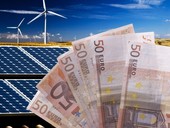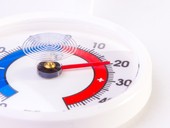One of the most well-known and most important greenhouse gases is carbon dioxide (CO2), which arises from natural processes, but the burning of carbonaceous fuels, especially fossil fuels, contributes significantly in the last century. This text focuses on CO2 emissions associated with energy transformations for the supply of energy to buildings.
Archiv článků od 23.1.2017 do 19.3.2018
The aim of this paper is to compare BaP emissions from domestic heating, industrial emissions of BaP and BaP emissions from transport within the scope of the Czech Republic and individual regions of the Czech Republic using current balance approaches that are used for reporting BaP emissions for the Czech Republic under the Convention on Long-range Transboundary Air Pollution (CLRTAP).
In the area of existing thermal energy supply systems, the processes of disconnection of existing heat consumers have been ongoing for a long time. The key point is correctness of the Energy Certificates. The article provides an example of a specific assessment of disconnection from central source heat supplier.
Assessing energy performance of the building is also done from the point of view of the need for non-renewable primary energy. A common layman probably does not know what this means. At the same time, the need for non-renewable primary energy fundamentally influences the design of energy sources for heating, cooling, hot water preparation, etc. for a particular building. The need for non-renewable primary energy is one of the three main energy performance indicators of a building, and if it is assessed as too large, the building can not be validated.
Another of several articles dealing with thermal losses evaluation of heating networks is focused on the numerical modeling of the temperature field in the immediate and distant surroundings of the pipe insulation surface. In connection with the difficulty of solving the analytical methods and in particular with the inaccuracy of their results, especially in less typical but not rare operating regimes, a two-dimensional model of the thermal field generated during the operation around the heating pipeline is offered as a suitable path for describing the whole process. The presented numerical model uses the growth of computational capacities in recent years, so that the size of one segment of the calculation grid is 10 x 10mm, which is, for example, to determine the suitability of the location of another pipe network or cable, near the hot-water pipe, the fineness is already sufficient. The resulting numerical model is being prepared, unlike a substantial part of the analytical methods, to calculate the full range of possible operating conditions of the hot-water and climatic conditions on the Earth's surface.
Another of several articles dealing with thermal losses evaluation of heating networks is focused on the numerical modeling of the temperature field in the immediate and distant surroundings of the pipe insulation surface. In connection with the difficulty of solving the analytical methods and in particular with the inaccuracy of their results, especially in less typical but not rare operating regimes, a two-dimensional model of the thermal field generated during the operation around the heating pipeline is offered as a suitable path for describing the whole process. The presented numerical model uses the growth of computational capacities in recent years, so that the size of one segment of the calculation grid is 10 × 10 mm, which is, for example, to determine the suitability of the location of another pipe network or cable, near the hot-water pipe, the fineness is already sufficient. The resulting numerical model is being prepared, unlike a substantial part of the analytical methods, to calculate the full range of possible operating conditions of the hot-water and climatic conditions on the Earth's surface.
The article deals with the measurement of temperature field around the underground pipeline and compared heat losses derived from the measured values, the values calculated by different methodologies and its content fits into a several-cycle of articles on the topic of heat transfer in the field of underground pipeline in terms of quantifying heat loss and the extent and the intensity of the thermal field generated in the vicinity of the pipeline network.
Explosion parameters are currently published mainly for pure substances under standard laboratory conditions (20 °C and 101 kPa according to IUPAC). No values for the explosion characteristics of biomass and airborne gas mixtures are covered in the literature to cover non-standard conditions. In this paper, maximum explosion pressure, pmax, maximum explosion pressure rise rate (dp/dt)max, and deflagration index, KG, mixtures of hazardous chemicals from biomass gasification and measured at 25 °C, 45 °C, 90 ° C and 50 kPa, 75 kPa and 100 kPa.
The article deals with the measurement of temperature field around the underground pipeline and compared heat losses derived from the measured values, the values calculated by different methodologies and its content fits into a several-cycle of articles on the topic of heat transfer in the field of underground pipeline in terms of quantifying heat loss and the extent and the intensity of the thermal field generated in the vicinity of the pipeline network.
The article introduces a brief history of gasification and gasification equipment located at the premises of Energy Research Center at VSB - Technical University of Ostrava. Gasification at the Energy Research Center has a ten-year tradition. The beginnings date back to 2006, when cooperation was initiated with the Ostrava company TEMEX, spol. s.r.o. by the construction of the first version of the gasifier with autothermal generator.
Czech Statistical Office published in the February 2017 data from a large sample survey in Czech households with an Energy 2015. This survey was focused mainly on the consumption structure and methods of use of particular fuels and energy. The data focus on historical comparisons and consumption trends from 1991 to 2015. The statistics include methods of thermal insulation of housing, fuel used for heating and hot water, the average consumption of Czech households, types of heating sources, etc.
Total cost of heating energy typically consists of two items. The former is the payment for consumed energy while the latter is the payment for reserved power capacity or reserved energy capacity in given period. If the customer pays for the reserved power capacity, he/she should address two questions: what is the most suitable level of reserved capacity and how to control the heating system so that the reserved capacity limits are not exceeded. Both questions can be readily solved with the aid of model based predictive controller.
Paper describes selected effects of implementation of biomass microCHP generation in Czech legal conditions. Selected demonstration of biomass CHP is described and basic operational energy balances are presented. Comparison of microCHP and ordinary biomass boiler energy balance were performed. MicroCHP technology WAVE, which is being developed at CTU UCEEB in Buštěhrad, is described. Operational parameters of WAVE and future development outline were discussed.
zpět na aktuální články

![Comparison of benzo[a]pyrene emissions from each source category](/docu/clanky/0170/017074ou.jpg)

















